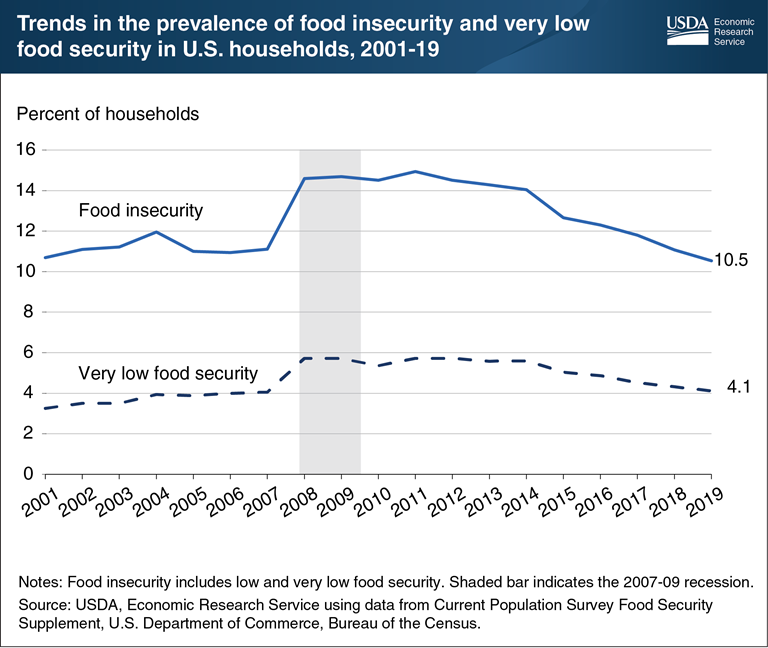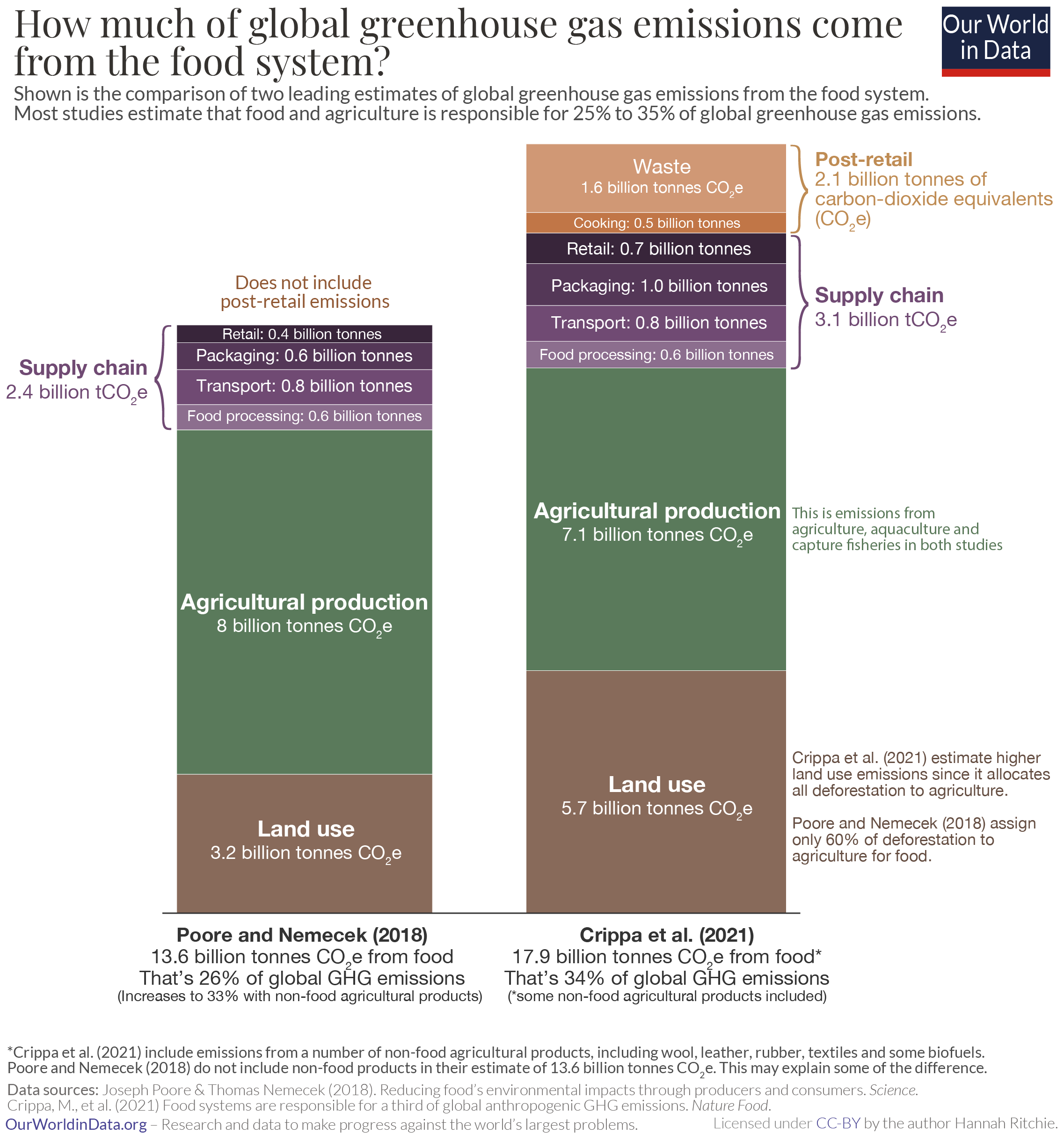Higher yields do not reflect the overall health of the food system or the American people.
Figure 1: Impacts of global recession on food security (source: USDA)
US farm output was 2.9 times higher in 2017 than in 1948, largely due to mechanization and the use of chemicals. Yet as of 2019, approximately 10 percent of US households, upwards of 35 million people, were food insecure. Food insecurity rates are highly responsive to economic downturns and recessions (see Figure 1) — not to agricultural productivity rates.
Furthermore, yield-centric metrics do not differentiate among crops based on nutrition, destination, or use.
The highest yields are seen in commodity crops, like soy, wheat, and corn, that are not primarily destined for direct human consumption. For example, most corn (maize) grown in the US is used for animal feed or ethanol production. Large-scale production of these crops is sustained through heavy taxpayer-funded subsidies from the US government (in other words, they are not as economically “efficient” as they might seem).
The pursuit of higher yields as a central goal has also had numerous negative consequences, both for communities and the environment.
Impacts on rural communities:
Ishii family farm, ca. 1935, near the Duwamish River in Seattle, WA (source: Seattle Then and Now)
Government policies, infrastructural development, corporate pressures, and other factors combined to increasingly consolidate land and agricultural production over the course of the 20th century. During World War I, the US encouraged farmers to produce record yields of crops and livestock in service of the war effort. The continued emphasis on productivity after the war led to a glut and a vicious cycle of low prices, debt, and overproduction. By the 1930s, between decreasing prices and the effects of the Dust Bowl on certain areas of the country, many farmers went bankrupt and lost their farms. In spite of some attempts by the government to reduce overproduction, farmer bankruptcy rates increased steadily until World War II.
During and after World War II, the US government pressured farmers once again to increase yields. At an accelerating rate from the 1940s and 50s onward, the number of farmers decreased while the average farm size increased (see Figure 2). The number of family farmers decreased further from the mid-20th century onward, from 7.6 million in 1950 to 2.06 million in 2000. Increased mechanization over the same period has also led to decreases in the numbers of hired farmworkers, from 2.33 million in 1950 to about half that in 2000.
Figure 2: Changes in farm size and number over the 20th century (source: Iowa Agriculture Literacy Foundation)
The aggressive pursuit of surplus and higher yields ramped up even more under President Nixon’s Secretary of Agriculture, Earl Butz, who pushed farmers to plant “from fencerow to fencerow” and systematically dismantled government protections for farmers established in the New Deal era. This resulted in the overproduction, collapsing prices, and record debt and foreclosures that characterized the farm crisis of the 1980s.
Farmers have long been one of the most at-risk populations for depression and suicide. During the farm crisis, the suicide rate among farmers peaked at 58 suicides per 100,000 farmers in 1982. Facing continued issues of mounting debt and decades of rural crisis, more than 450 farmers across the Midwest died by suicide from 2014 to 2018. According to 2016 data collected by the National Violent Death Reporting System, the suicide rate among farmers was 43.2 out of 100,000. (For comparison, the average rate for the US population in 2017 was 18 suicides per 100,000 people).
Impacts on the environment:
As of 2018, agriculture directly contributed 10 percent of all US greenhouse gas emissions (amounting to 698 million metric tons of CO2 equivalent). Indirectly, its impact is far greater, through food processing, fertilizer production, and transportation. As estimated by the Intergovernmental Panel on Climate Change, when factoring in these related industries, global agriculture is responsible for 21-37 percent of all greenhouse gas emissions (see Figure 3).
Figure 3: Two estimates of agriculture’s contribution to global greenhouse gas (GHG) emissions (source: Our World in Data)
Worldwide, the expansion and intensification of industrial agriculture is the number one contributor to biodiversity loss. Excessive application of fertilizers containing nitrogen and phosphorus leads to nutrient pollution and algal blooms that create dead zones in bodies of water — most notably, the Gulf of Mexico.
Meanwhile, the drinking water of millions of Americans living in or near farming communities across the country is contaminated by dangerous amounts of nitrates and coliform bacteria from fertilizer and manure. And farmworkers — often immigrants — are disproportionately exposed to the hazards of chemical pesticides and fertilizers.
Farmworker spraying pesticides in soybean field (source: Earth Justice)
SOURCES AND ADDITIONAL READING:
USDA Economic Research Service, Agricultural Productivity in the US
USDA (Sept 2020), Household Food Security in the United States in 2019
USDA Economic Research Service (2019), Corn-based ethanol production in the United States has plateaued in recent years
Elanor Starmer, Aimee Witteman, and Timothy A. Wise (2006), Feeding the Factory Farm: Implicit Subsidies to the Broiler Chicken Industry
Food Print, Sustainable Agriculture vs. Industrial Agriculture
Tom Morain, The Great Depression Hits Farms and Cities in the 1930s, Iowa Pathways on Iowa PBS
Donald Worster (1979), The Dust Bowl: The Southern Plains in the 1930s
Jerome M. Stam and Bruce L. Dixon (2004), Farmer Bankruptcies and Farm Exits in the United States, 1899-2002, USDA Economic Research Service
Stephanie A. Mercier and Steve A. Halbrook (2020), Agricultural Policy of the United States: Historic Foundations and 21st Century Issues
Carolyn Dimitri, Anne Effland, and Neilson Conklin (2005), The 20th Century Transformation of U.S. Agriculture and Farm Policy, USDA Economic Research Service
USDA Economic Research Service, Farm Labor
Tom Philpott (8 Feb 2008), A reflection on the lasting legacy of 1970s USDA Secretary Earl Butz, Grist
Associated Press (14 Oct 1991), Farmer Suicide Rate Swells in 1980's, Study Says, New York Times
Katie Wedell, Lucille Sherman, and Sky Chadde (9 Mar 2020), Midwest farmers face a crisis: hundreds are dying by suicide, USA Today
Cora Peterson et al. (2020), Suicide Rates by Industry and Occupation — National Violent Death Reporting System, 32 States, 2016, Centers for Disease Control and Prevention Morbidity and Mortality Weekly Report
US Environmental Protection Agency, Sources of Greenhouse Gas Emissions
Intergovernmental Panel on Climate Change (2020). Climate Change and Land: Summary for Policymakers
Tim Benton et al. (3 Feb 2021), Food system impacts on biodiversity, Chatham House
Jackie Wang, Nicole Tyau, and Chelsea Rae Ybanez (16 Aug 2017), Farming activity contaminates water despite best practices, The Center for Public Integrity
Farmworker Justice (2013), Exposed and Ignored: How Pesticides are Endangering our Nation’s Farmworkers




